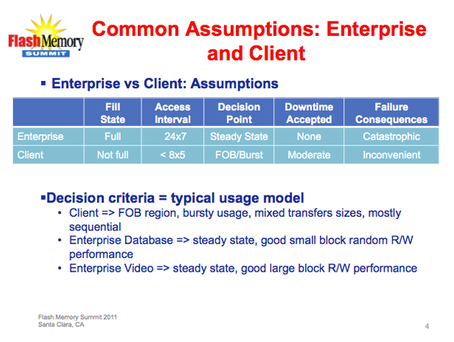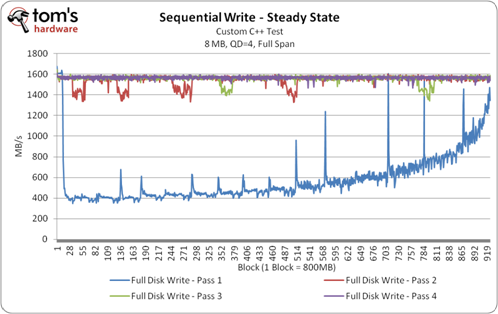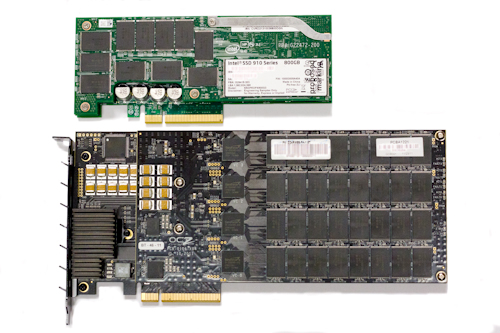Intel SSD 910 Review: PCI Express-Based Enterprise Storage
PCIe-based SSDs have evolved rapidly, with companies like Fusion-io, LSI, and OCZ leading the way. Intel is betting that its reputation for quality and reliability in the enterprise sector are enough to overcome that head-start as it launches SSD 910.
Testing Methodology
As we have pointed out in the past, and as we're sure you would have concluded logically on your own, an enterprise storage workload is quite different from desktop or client workloads. The differences between them affect how we test, analyze, and evaluate enterprise-oriented devices. The slide below, from last year’s Flash Memory Summit, gives a great overview of the differences.
SSDs are not easy to evaluate. Unlike traditional rotating disks, solid-state drives are affected by many factors that are difficult to control.
The Storage Networking Industry Association (SNIA), a working group made up of SSD, flash, and controller vendors, has produced a testing procedure that attempts to control as many of the variables inherent to SSDs as possible. SNIA’s Solid State Storage Performance Test Specification (SSS PTS) is a great resource for enterprise SSD testing. The procedure does not define what tests should be run, but rather the way in which they are run. This workflow is broken down into four parts:
- Purge: Purging puts the drive at a known starting point. For SSDs, this normally means Secure Erase.
- Workload-Independent Preconditioning: A prescribed workload that is unrelated to the test workload.
- Workload-Based Preconditioning: The actual test workload (4 KB random, 128 KB sequential, and so on), which pushes the drive towards a steady state.
- Steady State: The point at which the drive’s performance is no longer changing for the variable being tracked.
These steps are critical when testing SSDs. It is incredibly easy to not fully condition the drive and still see fresh-out-of-box behavior and think it is steady-state. These steps are also important when going between random and sequential writes.
The graph below demonstrates the rationale behind SNIA's guidelines on Intel's SSD 910. We first performed a Secure Erase (Purge), followed by five full disk writes of random 4 KB data (Workload-Independent Preconditioning). Then, we wrote the full capacity of the disk four times in a row with 8 MB sequential writes (Workload-Based Preconditioning). It wasn’t until the fourth full disk write that we achieved Steady State.
For all performance tests in this review, the SSS PTS was followed to ensure accurate and repeatable results.
Finally, the SSS PTS mandates that all data patterns be random. This is an attempt to normalize results for SSDs that optimize performance for compressible data. In general, the compressibility of data is very case-dependent. So, to represent worst-case scenarios, random data is used when applicable in the performance tests. It should be noted that Intel's SSD 910 does not perform any data compression, and the results for compressible data are identical.
Get Tom's Hardware's best news and in-depth reviews, straight to your inbox.
Intel sent us an 800 GB sample of its SSD 910 for evaluation. We ran tests in both Maximum Performance mode and its Default mode. To simulate the performance of the 400 GB model, we only configured two of the four NAND modules, per Intel’s instructions. The evaluation unit did not come with a full-height PCIe bracket, so testing was performed without one installed.
For comparison purposes, we're putting Intel's SSD 910 up against OCZ's Z-Drive R4 RM88 1.6 TB. Is this a fair fight? No, it isn’t. The R4 sports two times the capacity, twice as many controllers, it requires a ¾-height, full-length PCIe slot, and sells for somewhere around $7/GB. Since the R4 uses SandForce-based controllers, though, we wanted to see how much of a fight the SSD 910 can put up, especially since most of our testing is being performed with incompressible data, a known problem for SandForce's technology.
-
that is one fast Sequential read speed. It to bad that they will be $1000+ market and out of reach of all but the server/ workstation crowdReply
-
The OCZ is tested with compressible data? talk about best case scenario. what were the incompressible results like?Reply
-
s3anister PCI-E Solid State Storage is great but I can't help but wonder; where is the Memristor? The true performance gains to be had are with massive RAM-disks that aren't volatile.Reply -
apache_lives The most important and un-comparable factor here is 5 years later those Intel SSD's will still be functional, any other brand im surprised they last 5 months in normal machines with the failure rates i have seen first hand - OCZ, GSkill etc there all horrible i bought an Intel SSD for this reason - THEY WORK.Reply
Review sites never cover real world use - that is to live with it day in day out (reliability), its not all about raw speed and performance. -
ZakTheEvil Yeah, consumer SSD reliability is a bit of disappointment. At best they seem to be as reliable as hard drives.Reply -
georgeisdead This is a note to address several articles I have come across lately that state intel's reputation for quality and reliability in the SSD market as if it is a given. These comments are from my personal experience with intel's drives. I have owned 3 intel solid state drives, one X25-M G1, and two X25-M G2's. The X25-M G1 failed after 2 years while one of the G2 drives failed after 2.5 years. Now, I am not an expert on MTBF and reliability, but in my opinion this is a pretty poor track record. It is entirely possible that this is a coinicidence, however both drives failed in the same manner, from the same problem (determined by a third party data recovery specialist): Bad NAND flash.Reply
As best I understand it as it was descibed by the company that analyzed these failed drives, a block of NAND flash either went bad or became inaccessible by the controller rendering the drives useless and unable to be accessed by normal means of hooking it up to a SATA or USB port. Two drives, different NAND (50 nm for the G1 and 34 nm for the G2), same failure mode.
Once again, this is not definitive, just my observations but to me, I think review sites need to be a little more cautious about how they qualify intel's reputation for quality and reliability because from my perspective, intel has neither and I have since began using crucial SSD's. Hopefully, I will see much longer life from these new drives. -
jdamon113 I would like to see something like this stacked in our EMC, Could this drive with a rack of othere just like it, run 24/7 for 3 + years, Sure we replace a drive here and there in our EMC, but the unit as a whole has never went down in its 5 year life.Reply
Intel, you should test these drive in that real world application. EMC, VM-ware and several data bases carve out some LUN's and Push the envelope. In this situation, should the device prove worthy, the 4000 price tag will come down very fast, and the data center will put it trust in product, So for those reading this for your personal home workstation and gaming ridge, you need not apply in this arena.
Intel is just about 18-months 2 years of owning the data center, Even EMC is powered by intel. -
jaquith Enterprise e.g. SQL you need SLC otherwise you'd be making a career replacing drives. The cost is down time and replacement. I can write more 'stuff' but it's that simple. For our IDX and similar read data it about reliability and capacity.Reply -
willard razor7104that is one fast Sequential read speed. It to bad that they will be $1000+ market and out of reach of all but the server/ workstation crowdThat's because this was not designed for consumers. It's not like they're marking the price up 1000% for shits and giggles. Enterprise hardware costs more to make because it must be much faster and much more reliable.Reply
This drive, and every other piece of enterprise hardware out there, was never meant to be used by consumers. -
drewriley jimbob rubaeThe OCZ is tested with compressible data? talk about best case scenario. what were the incompressible results like?Reply
Check out the Sequential Performance page, lists both compressible and incompressible. For all the other tests, random (incompressible) data was used.


